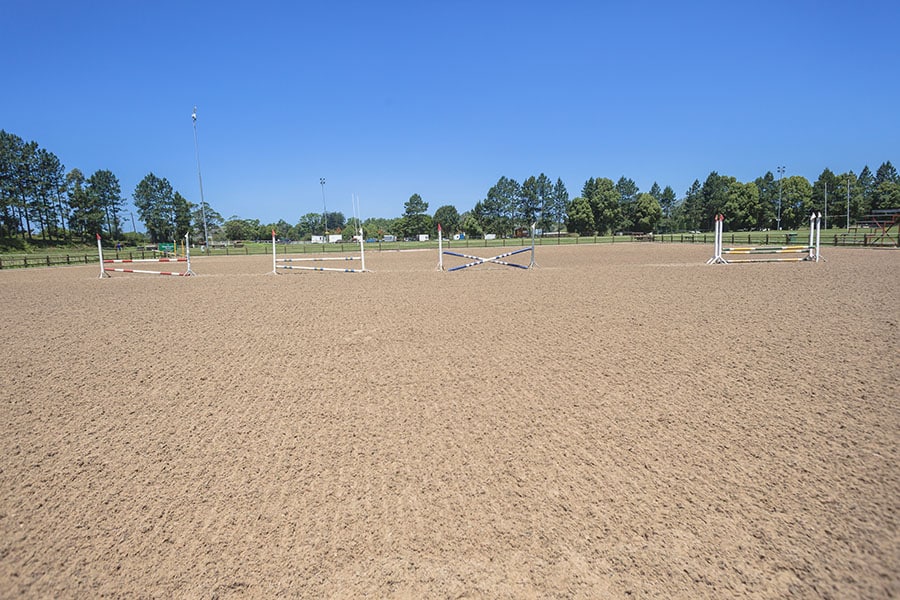When developing and maintaining a horse arena, you have to balance so much. Initial cost, maintenance expenses, time requirements for repairs and maintenance, and the overall quality of the arena surface are all critical factors that are often at odds with each other.
Regardless of your arena size and whether it’s indoor or outdoor, watering is the most common horse arena footing maintenance strategy.
While it’s generally effective, horse arena watering can be expensive and time-consuming, depending on your watering strategy and specific arena. Assuming standard moisture levels, the typical outdoor arena will require more than 2,500 gallons of water daily. This increases your water bill and necessitates additional help to manage the horse arena watering process.
So can you do anything about it?
There are options and techniques that reduce the amount of water you need to use, and there are also setups that don’t require any watering.
How Much Water Does My Arena Need?
Watering an equestrian arena is the most traditional method to keep the footing in good shape. Failing to properly water a dressage arena leads to excessive dust and less traction and support for the horses.
But overwatering can be just as problematic. Too much water, especially if applied inconsistently, can result in squishy ground with insufficient traction or support.
There’s a simple test you should conduct to see if your arena footing has the proper composition. Take a handful of the footing, ball it up, and drop it. If the ball mostly stays intact but gives way on the landing, then the footing has a proper composition.
But how do you determine how much water you actually need to maintain that proper footing composition? There are a variety of factors that will impact how much water your arena actually needs.
Indoor or Outdoor
The location of your arena is one of the most important determining factors for the amount of water that you will need. Outdoor arenas are exposed directly to the elements, including wind, sunlight, and rain. This can cause variability and necessitate even more arena maintenance.
Climate
The average climate where your arena is located will dictate how much water is needed. This includes temperature, humidity levels, and precipitation (at least for outdoor arenas). Outdoor arenas with dry climates, high temperature, regular exposure to strong wind, and low humidity levels will require more water than indoor arenas or those in more mild weather.
Footing Depth and Composition
In addition to the previous factors, the depth and composition of the footing will influence the amount of water you need. The deeper your arena footing, the more water will be required. Whether or not the footing includes additives and the percentage of sand also play a role.
How can I Water My Arena Less?
There are some steps that you can take so that you don’t need to water your arena base as often. Both of these approaches still require watering but can reduce the frequency and volume needed.
Additives
There are many different additives that you can include in your arena footing. Some of these footing products reduce the amount of water required by enhancing the footing’s capability to absorb water. Other products help the footing to retain water once it is absorbed.
A very popular additive is magnesium chloride, which works by moving moisture out of the air and into the footing. This helps to prevent freezing and functions as a dust control measure.
Techniques and Equipment
The techniques and equipment that you use is just as important as the amount of water that you spray on the footing in your arena.
How you water your arena will greatly influence your costs and the quality of the riding surface. For instance, someone who uses a garden hose will sprinkle uneven water levels across the arena, causing the footing to be inconsistent. While this option is less expensive, it requires significantly more manpower and is less effective.
Installing an automated horse arena water system with irrigation requires a larger upfront investment but reduces the amount of time you will need to spend watering.
What is a Waterless Arena?
Thanks to technological advancements and unique footing materials, there are also some horse arenas that do not need any watering. These waterless footing materials do not require top footing or sand and are usually placed directly on top of a free draining base.
Our waterless arena footing is composed of carefully manufactured sand alongside proprietary natural binding agents and fibers.
Is a Waterless Arena Worth It?
WIth traditional footing that is composed of arena sand and additives you have to complete significant maintenance on a regular basis. Your daily maintenance schedule includes watering and dragging, and cleaning. On a weekly basis, you will be mixing in more additives and raking.
Depending on your use and schedule, having a waterless arena can reduce many of those requirements.
With properly-installed waterless riding arena footing, you can expect the following benefits:
- Dust free
- No watering
- Great cushion and support
- No additives
Footing that Combines Performance and Price
Developing and maintaining a quality horse arena is complicated, time-consuming, and can be expensive. We offer a wide range of footing materials, drags, bases, additives, and other equipment to help keep it simple and less expensive.
We have extensive knowledge of the equestrian industry and understand the needs of our riders and horses. Whether you are looking into developing a new arena or improving an existing one, we help you provide high-quality riding facilities.
Contact our Footing Specialists today by calling (877)-835-0878 so we can consult your arena(s).
